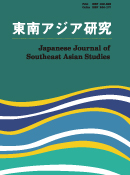Volume 7, Issue 2
Displaying 1-15 of 15 articles from this issue
- |<
- <
- 1
- >
- >|
Articles
-
1969Volume 7Issue 2 Pages 148-162
Published: September 30, 1969
Released on J-STAGE: June 06, 2019
Download PDF (710K) -
1969Volume 7Issue 2 Pages 163-176
Published: September 30, 1969
Released on J-STAGE: June 06, 2019
Download PDF (1057K) -
1969Volume 7Issue 2 Pages 177-190
Published: September 30, 1969
Released on J-STAGE: June 06, 2019
Download PDF (815K)
Notes
-
1969Volume 7Issue 2 Pages 191-197
Published: September 30, 1969
Released on J-STAGE: June 06, 2019
Download PDF (386K) -
1969Volume 7Issue 2 Pages 198-208
Published: September 30, 1969
Released on J-STAGE: June 06, 2019
Download PDF (687K)
Report
-
1969Volume 7Issue 2 Pages 209-216
Published: September 30, 1969
Released on J-STAGE: June 06, 2019
Download PDF (829K)
Book Reviews
-
1969Volume 7Issue 2 Pages 217-225
Published: September 30, 1969
Released on J-STAGE: June 06, 2019
Download PDF (901K)
Book Reviews
-
1969Volume 7Issue 2 Pages 226
Published: September 30, 1969
Released on J-STAGE: June 06, 2019
Download PDF (157K) -
1969Volume 7Issue 2 Pages 226-227
Published: September 30, 1969
Released on J-STAGE: June 06, 2019
Download PDF (255K) -
1969Volume 7Issue 2 Pages 227-228
Published: September 30, 1969
Released on J-STAGE: June 06, 2019
Download PDF (268K) -
1969Volume 7Issue 2 Pages 228
Published: September 30, 1969
Released on J-STAGE: June 06, 2019
Download PDF (172K)
News from the Field
-
1969Volume 7Issue 2 Pages 229-248
Published: September 30, 1969
Released on J-STAGE: June 06, 2019
Download PDF (1836K) -
1969Volume 7Issue 2 Pages 249-253
Published: September 30, 1969
Released on J-STAGE: June 06, 2019
Download PDF (654K)
Symposium
-
Article type: Appendix
1969Volume 7Issue 2 Pages 254-270
Published: September 30, 1969
Released on J-STAGE: June 06, 2019
Download PDF (1447K)
Correspondences
-
Article type: Appendix
1969Volume 7Issue 2 Pages 271-272
Published: September 30, 1969
Released on J-STAGE: June 06, 2019
Download PDF (93K)
- |<
- <
- 1
- >
- >|
